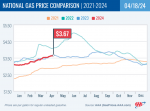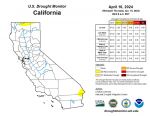
March 3, 2018 - By John Newton - Following multiple years of large harvests in the U.S., projections for record livestock, dairy and meat production in the current year and farm income at concerningly low levels, U.S. farmers and ranchers are actively seeking to enhance access in existing foreign markets like Canada, China, Japan, Mexico and South Korea, and gain access in new markets, for example by re-entering the Trans-Pacific Partnership.

(Left) John Newton
Efforts to improve U.S. agricultural trade include a North American Free Trade Agreement modernization, re-negotiation of the U.S.-Korea Free Trade Agreement, agricultural concessions as a result of U.S.-China Comprehensive Economic Dialogue, and renewed interest by the White House in the countries that comprised the Trans-Pacific Partnership. Additionally, there is interest in engaging with Japan—our fourth-largest agricultural trading partner—on a bilateral level.
During 2016, $85 billion in U.S. agricultural exports were delivered to China, South Korea, Canada, Mexico and the former TPP areas. Since 2000, trade to China, South Korea, Canada, Mexico and the TPP areas has represented between 56 and 63 percent of all U.S. agricultural trade.
Gains have already been made in efforts to reduce long-standing trade barriers. China is now allowing U.S. beef meeting certain specifications to enter the country, and a World Trade Organization ruling against China will result in lower tariffs on U.S. poultry exports. A revised NAFTA, which, among other improvements, could address Canada's dairy pricing provisions, would go a long way to making U.S. farmers and ranchers more competitive. Finally, Farm Bureau estimated the Trans-Pacific Partnership would have increased net farm income by $4.4 billion.
Challenges also exist. First, trade negotiators from Canada, Mexico and the U.S. have had six rounds of NAFTA negotiations, and rhetoric around a NAFTA termination remains. In the event of a NAFTA withdrawal, and barring congressional action denying the request, U.S. agricultural products would see substantially steeper barriers to trade.
Second, the Trump administration recently unveiled new tariffs on imports of Vietnamese-diverted Chinese steel, as well as solar panels and washing machines. These products are primarily made in China and South Korea, which represent our second- and fifth-largest agricultural trading partners, respectively. These recently imposed tariffs could potentially complicate recent gains for beef and poultry in China or efforts to improve the U.S.-Korea FTA. Additionally, South Korea and China could retaliate by imposing tariffs or non-tariff barriers on our agricultural products.
Third, the remaining 11 countries party to the Trans-Pacific Partnership recently resurrected and signed a new multilateral trade agreement, known as CPTPP. U.S. trade in agricultural products to these 11 countries—minus Mexico and Canada—represented 15 percent of our agricultural exports. Without being party to CPTPP, the U.S. will not have favored access to the agricultural markets in these countries and could lose market share in this high-growth and geopolitically important part of the world.
Finally, the European Union recently completed the Comprehensive Economic and Trade Agreement with Canada, the EU-Japan Economic Partnership Agreement, and the EU and Mexico are currently negotiating to modernize their trade agreement. EU trade agreements will increase competition for U.S. agricultural exports in these critical markets.
The U.S. Department of Agriculture Global Agricultural Trade System database provides state-level agricultural export data. It reflects where shipments are consolidated, and not necessarily where a commodity is produced, but can illustrate the importance of China, NAFTA, CPTPP and South Korea on U.S. agricultural trade.
On average, 62 percent of U.S. agricultural exports are delivered to China, NAFTA, CPTPP and South Korea. During 2016, about 61 percent of California agricultural exports went to those areas. Two-thirds of states had a higher export percentage to these areas than the U.S. average.
While most of the attention in U.S. agriculture has focused on a NAFTA modernization, there are several other opportunities available to simultaneously improve U.S. agricultural trade and boost farm income.
A modernized NAFTA with key Canadian concessions, more access into China, entering CPTPP, improving the U.S.-South Korea agreement or negotiating a bilateral trade agreement with Japan would improve the top markets the U.S. trades in—but challenges also exist. With more than 62 percent of U.S. agricultural exports represented by these areas, including NAFTA, the stakes are high. For obvious reasons, complications in other sectors such as autos, pharmaceuticals or manufacturing make agriculture anxious.
However, if the administration is successful, improved access in these areas will further enhance the importance of trade to the agricultural economy and to rural America. Consider a recent analysis from USDA indicating that "each dollar of agricultural exports stimulated another $1.28 in business activity. The $134.7 billion of agricultural exports in [2016] produced an additional $172.1 billion in economic activity, for a total economic output of $306.8 billion."
With record harvests and livestock production coming online, free, fair and open trade is key to U.S. agriculture's success. Now is the time to make agricultural trade great again by enhancing NAFTA, negotiating a U.S. position in CPTPP, engaging with Japan, improving KORUS and getting more access to the important Chinese market.
(John Newton is director of market intelligence for the American Farm Bureau Federation. He may be contacted at jnewton@fb.org.)
Reprinted with permission: California Farm Bureau Federation














































































